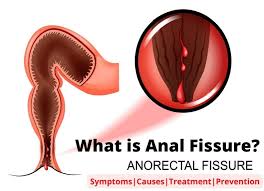Fissure Anatomy

Understanding the Structure and Function of the Area Affected by Fissures
A fissure is a small tear in the skin or lining of the anal canal, and its anatomy plays a key role in understanding how these tears form and how they heal. To effectively manage and treat anal fissures, it’s important to understand the anatomy of the region where they occur.
1. The Anal Canal: Where Fissures Form
The anal canal is the last part of the digestive tract, extending from the rectum to the anus. It is surrounded by muscles known as the anal sphincters, which control the passage of stool. The skin around the anal opening is sensitive, and any strain or trauma to this area can result in a tear, causing an anal fissure.
- External Anal Sphincter: This is the muscle you consciously control to keep the anus closed.
- Internal Anal Sphincter: This is an involuntary muscle responsible for maintaining continuous closure of the anal canal.
Fissures generally occur in the lower part of the anal canal, where the skin is delicate and prone to injury due to pressure during bowel movements.
2. The Role of the Anal Sphincters
The anal sphincters (internal and external) are vital to the formation of fissures. These muscles help regulate the opening and closing of the anus. When these muscles experience excessive strain, such as during constipation or hard bowel movements, it can lead to tearing of the skin in the anal canal.
- Tightened Sphincters: If the sphincters are in a constant state of tension, it reduces blood flow to the anal region, which slows healing and may cause the fissure to become chronic.
- Sphincter Spasms: These are often painful and can make the fissure worse, leading to further tissue damage.
3. Skin Around the Anus
The skin surrounding the anus is very sensitive, with a high density of nerve endings. This makes the area highly prone to discomfort when a fissure occurs. The skin’s thin nature contributes to its vulnerability to tearing, especially when subjected to forceful bowel movements or increased pressure.
4. Blood Flow and Healing
Blood flow to the anal region plays a crucial role in the healing process. Poor circulation can delay the healing of fissures, causing them to persist. This is one reason why treatments such as topical creams, ointments, and even Botox injections (which relax the anal sphincters and increase blood flow) are often used in managing anal fissures.
5. Common Causes of Fissures
Fissures typically occur when the tissue of the anal canal is stretched beyond its normal capacity. This can happen due to:
- Constipation and straining during bowel movements
- Passage of large or hard stools
- Diarrhea or frequent bowel movements
- Childbirth (for women)
- Anal intercourse
- Infections (such as sexually transmitted infections or tuberculosis)
Understanding the anatomy of the area affected by fissures helps in recognizing the causes and taking preventive measures to avoid the formation of fissures.
6. Treatments Based on Fissure Anatomy
Treatments for anal fissures aim to reduce pressure and improve blood flow to the area for faster healing. Some of the most common treatment options include:
- Topical Treatments: Creams and ointments that reduce pain and inflammation.
- Sphincterotomy: A surgical procedure that cuts part of the anal sphincter muscle to relieve pressure and improve blood circulation.
- Botox Injections: These relax the sphincter muscles and promote healing by increasing blood flow to the affected area.
- Laser Surgery: A minimally invasive option for faster recovery with less discomfort.
Understanding the Anatomy of Fissures for Better Care
Knowing the anatomy involved in fissures can help you better understand how the injury occurs and why certain treatments are more effective than others. By managing the pressure on the anal sphincters, ensuring proper blood flow, and using appropriate treatments, fissures can be healed effectively, often with minimal intervention.
If you’re struggling with a fissure or need professional guidance on how to treat it, Dr. Ankur Bhanushali specializes in advanced treatments like laser surgery and Botox injections for optimal care and faster recovery.
Contact Information:
📍 Dr. Ankur Bhanushali – Laser & Laparoscopic Surgeon
1st Floor, Aayush Multispecialty Hospital, Marigold Apartment, Almeda Road, Panch Pakhdi, Thane West – 400602
🌐 Website: https://www.drankurbhanushali.com
📍 GMB: https://maps.app.goo.gl/3Msc7YZqVkV9mQMQ7
📧 Email: dr.ankur.bhanushali@gmail.com
🔗 Facebook: https://www.facebook.com/profile.php?id=61573840205822
🔗 Instagram: https://www.instagram.com/surgeon_dr_ankur_bhanushali
🔗 LinkedIn: https://www.linkedin.com/in/dr-ankur-bhanushali-b85aab2a6/
Learn more about your condition and explore treatment options that can help you heal quickly and comfortably.
Laparoscopic Cholecystectomy Seamless Surgical Experience Surrounding Tissues Compared Monitor Ensuring Precision Latest Surgical Techniques Highly Effective Procedure Postsurgical Issues Making Patientcentered Approach Gallbladder Diseases Due Potential Complications Patient Wellbeing Make Diet Physical Activity Seasoned Professional Remarkable Reputation Follow Medical Advice Safety Effectiveness Extensive Experience Surgical Instruments Precision Expertise Treating Gallstones Quick Recovery Time Dr Ankur Bhanushali Postoperative Care Bleeding Infection Highest Standards Preferred Choice Preferred Method Expert Patients Leading Experts Smooth Recovery Opposite Nitin Surgeons Skill Minimal Trauma Minimal Risks Faster Return Surgeon Views 086910 33033 Bile Leakage Tiny Camera Wound Care
